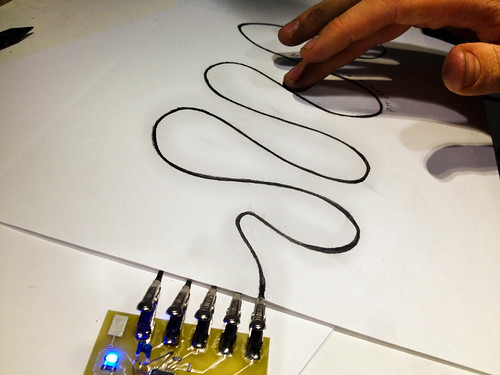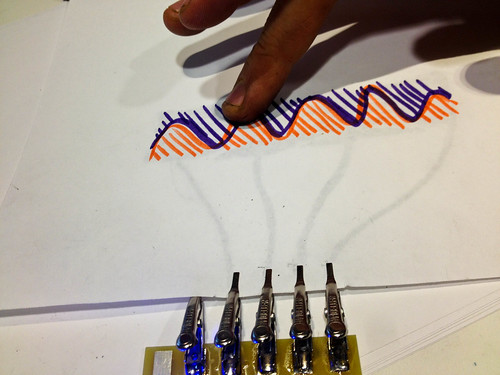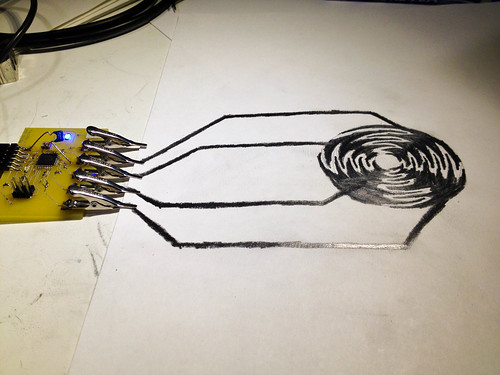Sliders & Wheels
Posted . [ ]
I headed over to Utrecht Art Supply earlier today to act on a hunch that I’ve had for awhile. They’ve got a nice selection of writing and drawing tools, and I picked up a variety of very, very soft graphite pencils. I didn’t even know they went up to 9B, but there it was—a gleaming rod of solid graphite. It had a nice heft to it, too. I got a range of hardnesses and headed back to the lab.
Graphite is reasonably conductive, which means that you can do all kinds of neat things with pencils. Jay Silver paved the way with the Drawdio, a beautiful project that grafts analog sound-generation onto an ordinary #2. I’ve had some trouble getting the kind of consistent conductivity that I need, though, to make some of the sensors I’m interested in—at least without tediously going over and over the same lines.

2900 9B, be still my heart. Smudged with my finger.
In a regular pencil, HB, say, there’s a fair amount of clay mixed in with the graphite to stiffen it up. That allows the tip to hold a thinner line and last longer, but naturally-enough, reduces its conductivity. With the 9B pencil, however, I found that I could make much more reliable lines in just a pass or two. Old news, probably, but fun to play with.
So-equipped with my quiver of new acquisitions, I started sketching out some of the interfaces that I’ve been thinking about with my TapClip project.
This was the first indication that things were working nicely. This line had a resistance of around 2 MΩ, which is fine for my purposes. The clip was triggering nicely, though the line is probably a foot-and-a-half long, at least.
Quick line, sketched out. TapClip is attached at the back.
As you slide your finger across sliders of this form, you create stronger electric field with one narrow slice and then another. By interpolating between those signals, you can accurately determine where exactly your finger is.
Interdigitated slider.
Capacitive sensing works through most substrates (like the glass in your phone, for example)—so as far as it’s concerned, you can use the sensor through the back of sheet. That’s nice for two reasons: first, you can draw whatever you’d like on top, and second, actually touching a capacitive sensor turns it into a resistive sensor, which can be a good (but complicating) thing.
And flipped over, (thanks for the tip, @mellis so you can draw whatever you want on the reverse. Works perfectly.
This is essentially that same slider, but bent into a wheel shape. It took some doing to come up with an algorithm that could accurately track your finger as it moves around the circle. Capacitive wheel.

This is a graph generated by a little script, that plots the signals from each portion of the wheel over time. If you look closely, you can see the signal passing smoothly from one capacitive region to the other.
Graph of scrolling over the wheel. Notice that the peaks are slightly offset.